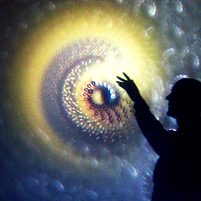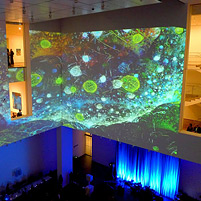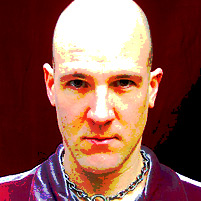Spot On

Draves' silhouette makes contact with the Electric Sheep

In the atrium at MoMA, 2010

Scott Draves
Scott Draves (CS'97) — a.k.a. Spot — returned to his alma mater recently to discuss the software behind his artwork.
Draves discussed his Electric Sheep project that combines his own open source genetic algorithms with "hot or not" voting and Darwinian evolution.
Electric Sheep: A cyborg creative mind — resulting from a massive Internet-wide art collaboration by 450,000 computers and their owners — that perpetually creates generative art.
In other words, through Draves' work, the design of Electric Sheep is influenced by user preferences and evolves over time — distributed computing to distributed intelligence. (Read more about Electric Sheep)
"Ultimately I am inspired by the beauty and complexity of the natural world, the diversity of life, and culture," he explained.
His computer art pieces in draft form are screensavers; Draves then chooses his own favorites to be re-rendered in high resolution for his museum-quality pieces. "Generation 244," the piece purchased by CMU's School of Computer Science, is one.
"I am a visual and software artist, one who develops new technology. The result is not only open-source algorithms and software that other people can use freely, but also my own art, which includes limited edition museum-quality works."
A Ph.D. graduate of computer science at CMU, Draves also discussed his web-GL project in progress, "Video Riot", done as part of his job at Google Inc. in New York City.
He created the original "Flame" algorithm in 1991, the "Bomb" visual-musical instrument in 1995, and the "Electric Sheep" in 1999.
"CMU was instrumental in my career and development. I really credit my advisors Dana Scott, Andy Witkin and Peter Lee who encouraged me and taught me and gave me the time and freedom that are required to do something new," he said.
Draves' software artworks are released as open source and have been used for two decades by many other artists and designers in their own work.
Draves' work is currently on display at LACMA and has been commissioned by CMU and the state-of-the-art Adler Planetarium in Chicago.
Other works have been acquired by corporate and private collections nationally.
Draves' website is permanently included on MoMA.org; his work has appeared in Wired and Discover magazines, as an official skin for Google Chrome, at the Museum of the Moving Image in New York City, at Art Basel in Miami, and as the graphic identity for Siggraph 2008.
"Can a computer be creative? Is humanity the only possible vehicle for what amounts to a soul? It really becomes a profound question that we are, as a society, really just starting to struggle with," Draves explained.
"Too many Hollywood stories are variations on Frankenstein and the Terminator. So when people encounter my work, I hope they'll see the potential of the virtual and of the machine, and to see them as part of us."
Related Links: Spot Blog | School of Computer Science
